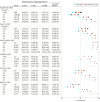Tumor-Infiltrating Lymphocytes in Triple-Negative Breast Cancer
- PMID: 38563834
- PMCID: PMC10988354
- DOI: 10.1001/jama.2024.3056
Tumor-Infiltrating Lymphocytes in Triple-Negative Breast Cancer
Abstract
Importance: The association of tumor-infiltrating lymphocyte (TIL) abundance in breast cancer tissue with cancer recurrence and death in patients with early-stage triple-negative breast cancer (TNBC) who are not treated with adjuvant or neoadjuvant chemotherapy is unclear.
Objective: To study the association of TIL abundance in breast cancer tissue with survival among patients with early-stage TNBC who were treated with locoregional therapy but no chemotherapy.
Design, setting, and participants: Retrospective pooled analysis of individual patient-level data from 13 participating centers in North America (Rochester, Minnesota; Vancouver, British Columbia, Canada), Europe (Paris, Lyon, and Villejuif, France; Amsterdam and Rotterdam, the Netherlands; Milan, Padova, and Genova, Italy; Gothenburg, Sweden), and Asia (Tokyo, Japan; Seoul, Korea), including 1966 participants diagnosed with TNBC between 1979 and 2017 (with follow-up until September 27, 2021) who received treatment with surgery with or without radiotherapy but no adjuvant or neoadjuvant chemotherapy.
Exposure: TIL abundance in breast tissue from resected primary tumors.
Main outcomes and measures: The primary outcome was invasive disease-free survival [iDFS]. Secondary outcomes were recurrence-free survival [RFS], survival free of distant recurrence [distant RFS, DRFS], and overall survival. Associations were assessed using a multivariable Cox model stratified by participating center.
Results: This study included 1966 patients with TNBC (median age, 56 years [IQR, 39-71]; 55% had stage I TNBC). The median TIL level was 15% (IQR, 5%-40%). Four-hundred seventeen (21%) had a TIL level of 50% or more (median age, 41 years [IQR, 36-63]), and 1300 (66%) had a TIL level of less than 30% (median age, 59 years [IQR, 41-72]). Five-year DRFS for stage I TNBC was 94% (95% CI, 91%-96%) for patients with a TIL level of 50% or more, compared with 78% (95% CI, 75%-80%) for those with a TIL level of less than 30%; 5-year overall survival was 95% (95% CI, 92%-97%) for patients with a TIL level of 50% or more, compared with 82% (95% CI, 79%-84%) for those with a TIL level of less than 30%. At a median follow-up of 18 years, and after adjusting for age, tumor size, nodal status, histological grade, and receipt of radiotherapy, each 10% higher TIL increment was associated independently with improved iDFS (hazard ratio [HR], 0.92 [0.89-0.94]), RFS (HR, 0.90 [0.87-0.92]), DRFS (HR, 0.87 [0.84-0.90]), and overall survival (0.88 [0.85-0.91]) (likelihood ratio test, P < 10e-6).
Conclusions and relevance: In patients with early-stage TNBC who did not undergo adjuvant or neoadjuvant chemotherapy, breast cancer tissue with a higher abundance of TIL levels was associated with significantly better survival. These results suggest that breast tissue TIL abundance is a prognostic factor for patients with early-stage TNBC.
Conflict of interest statement
Figures




Comment in
-
Prognostic Value of Tumor-Infiltrating Lymphocytes for Patients With Triple-Negative Breast Cancer.JAMA. 2024 Jul 23;332(4):337. doi: 10.1001/jama.2024.10480. JAMA. 2024. PMID: 38958961 Free PMC article. No abstract available.
References
Publication types
MeSH terms
Substances
Grants and funding
LinkOut - more resources
Full Text Sources

